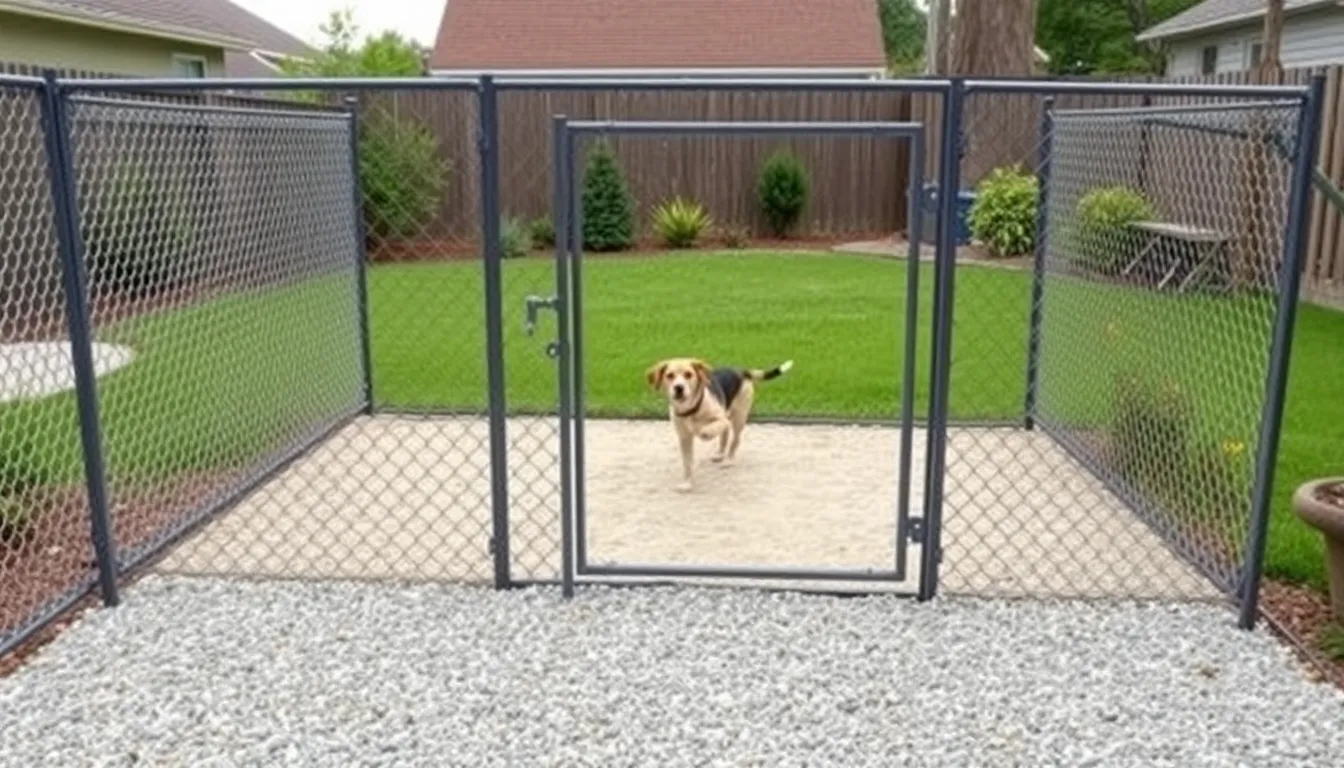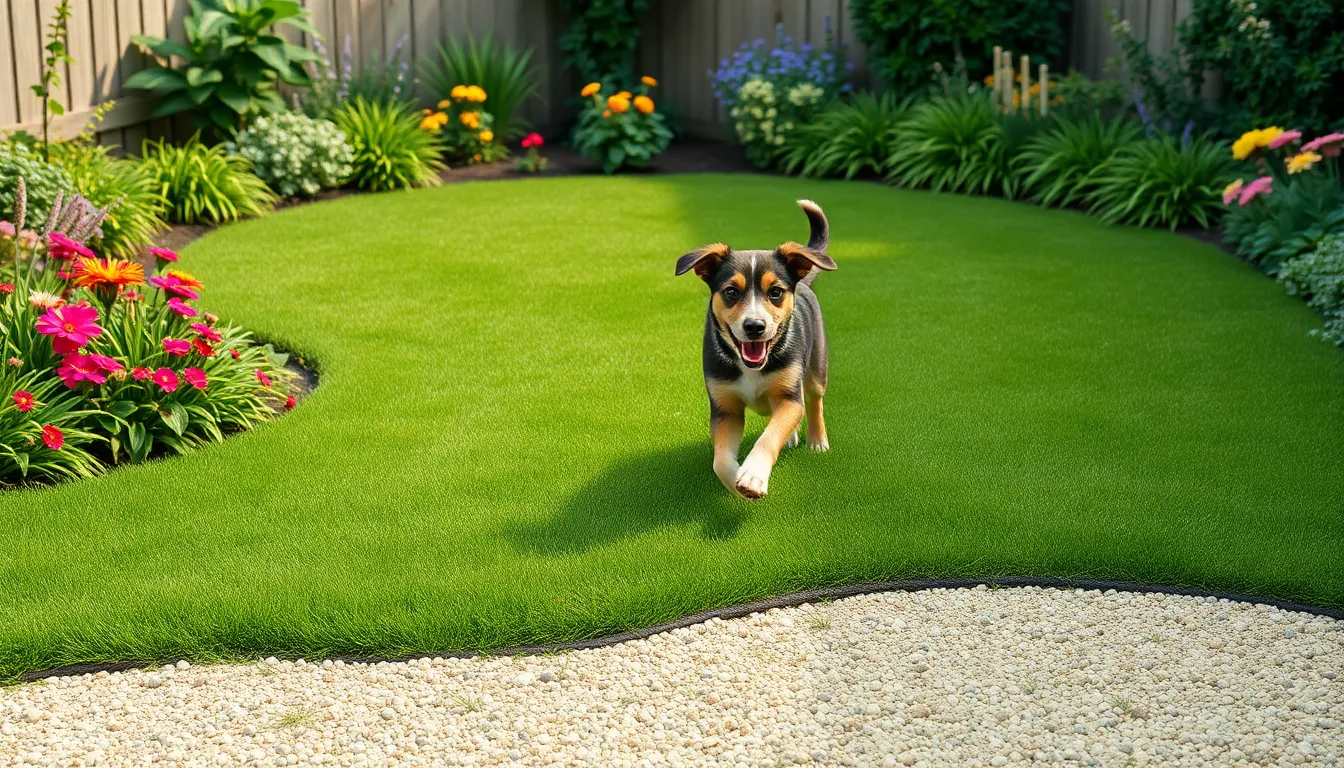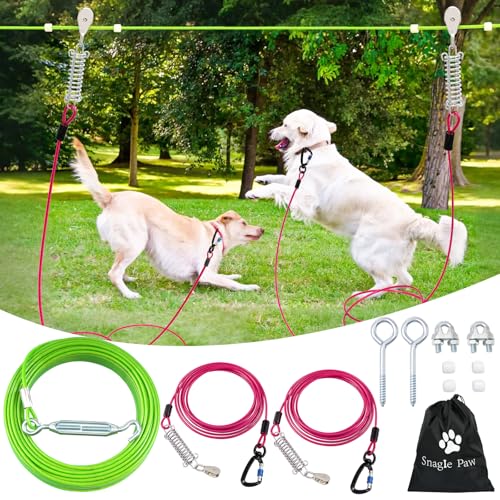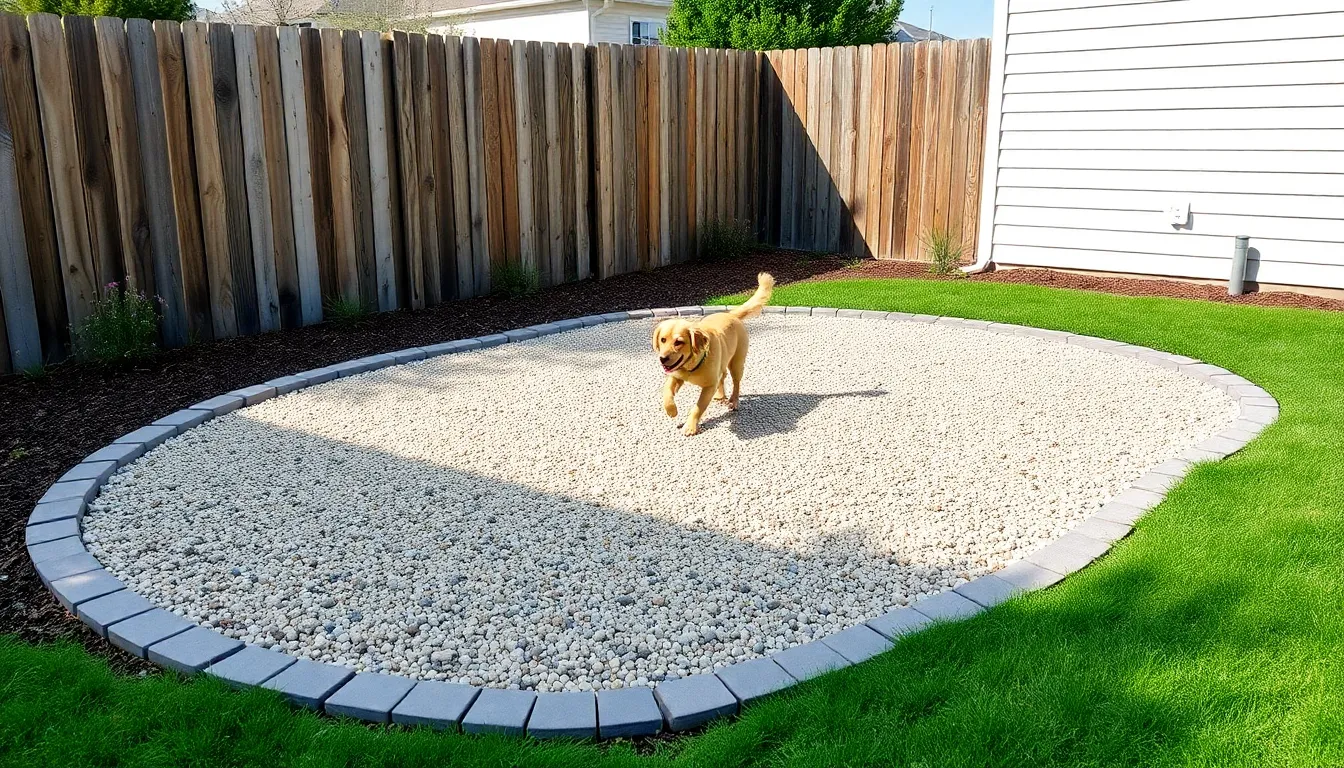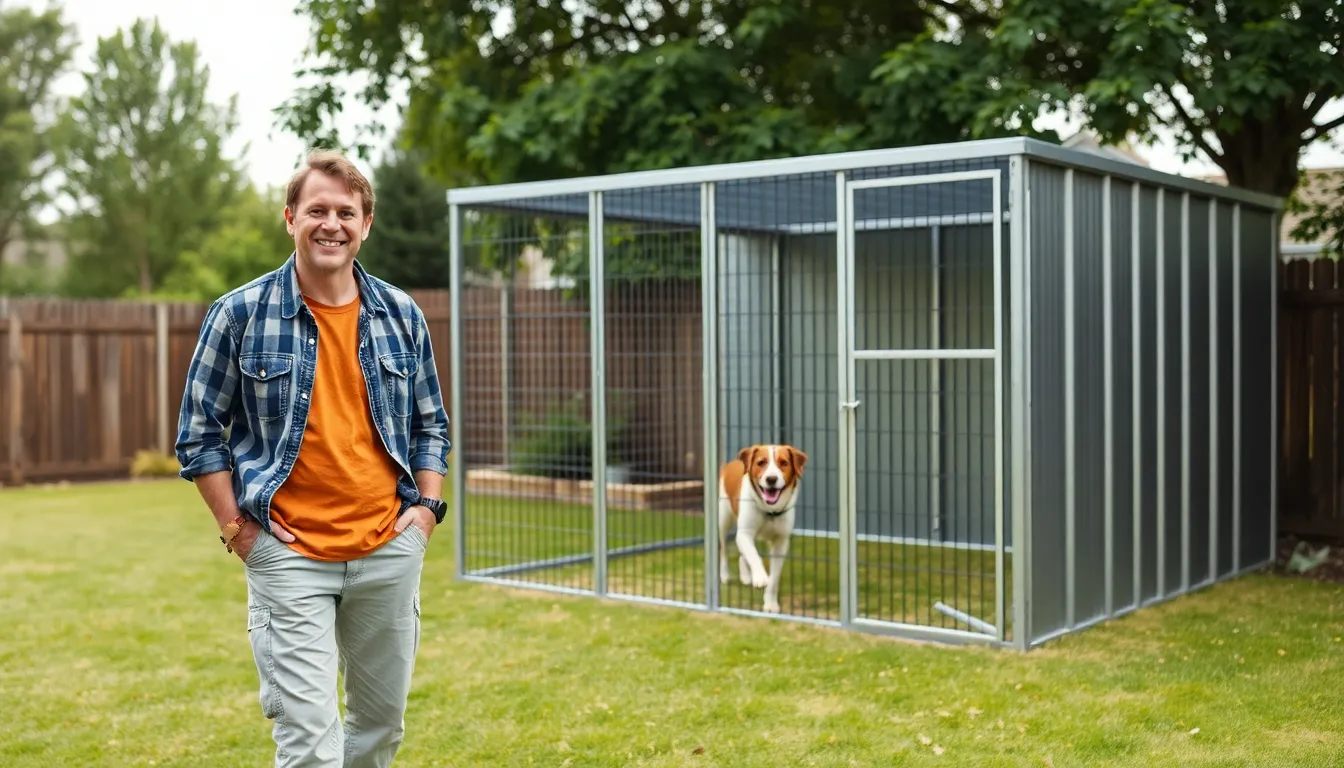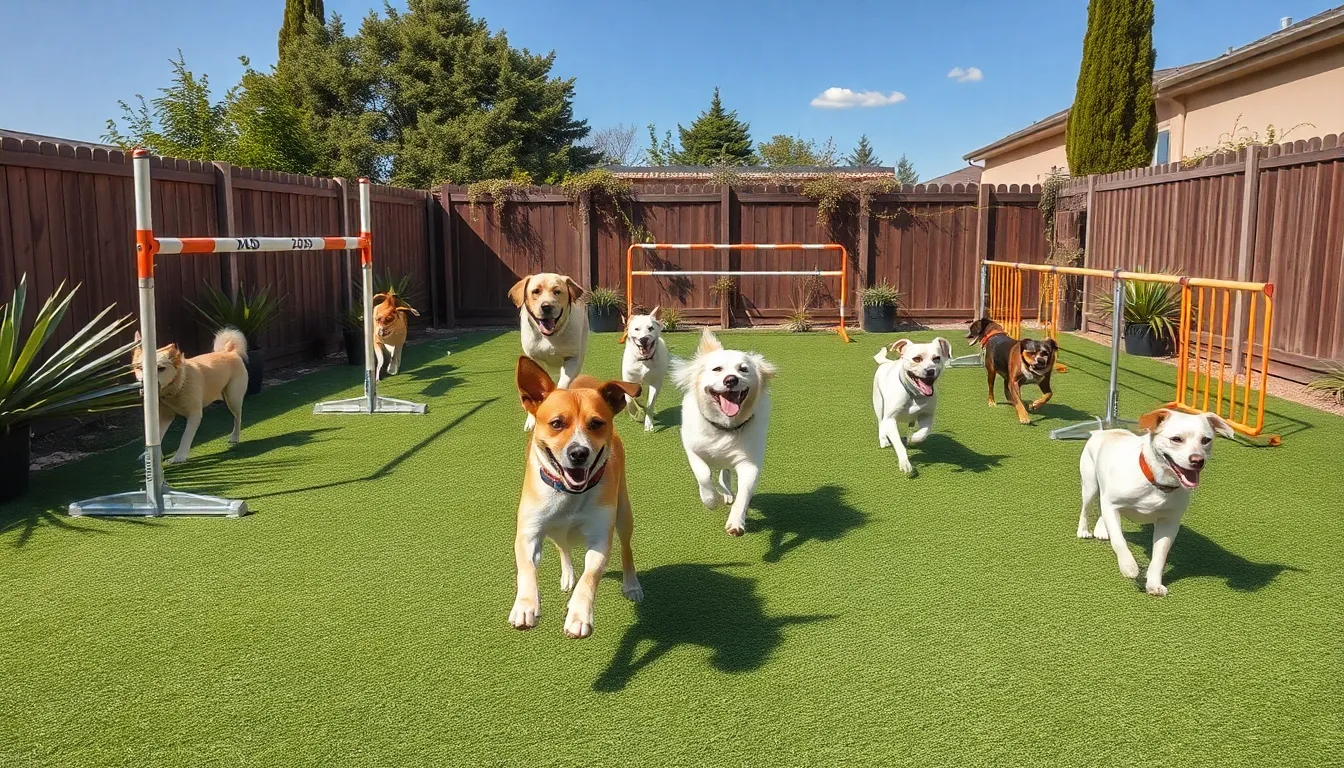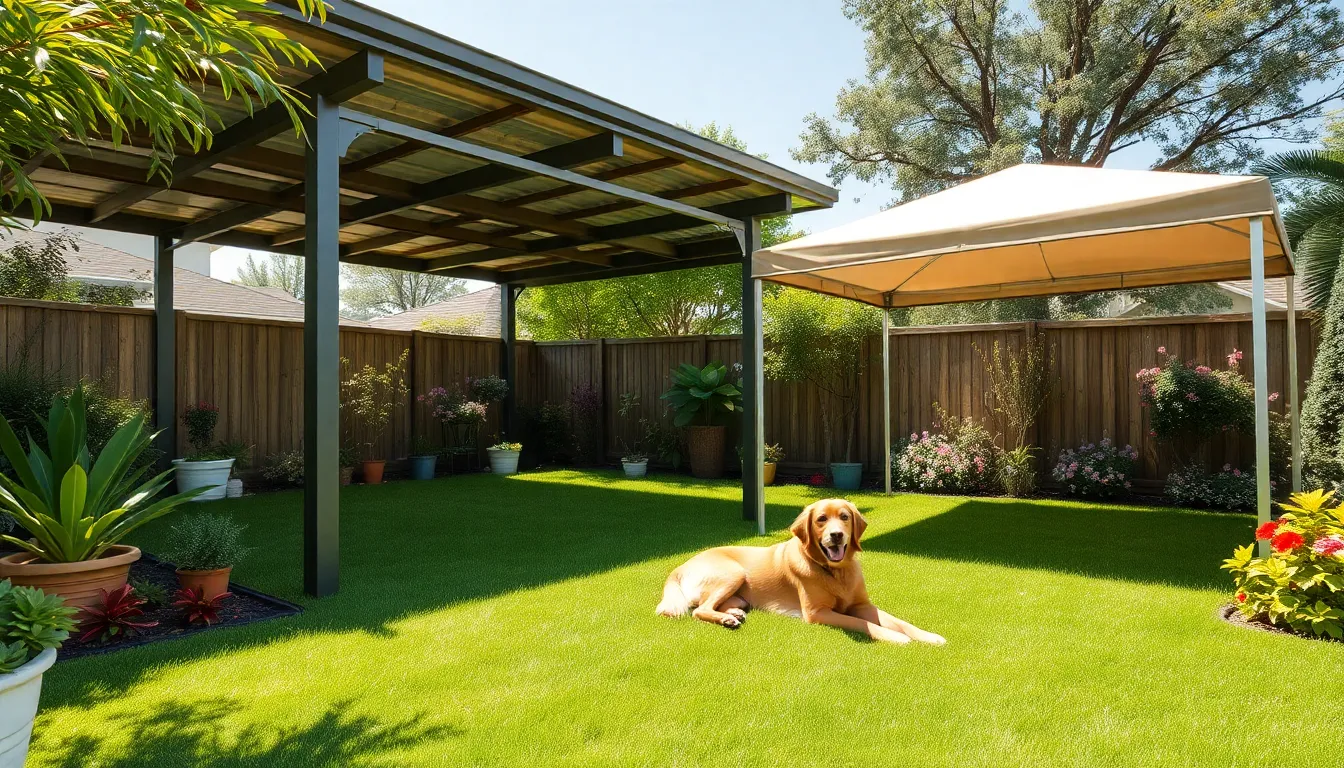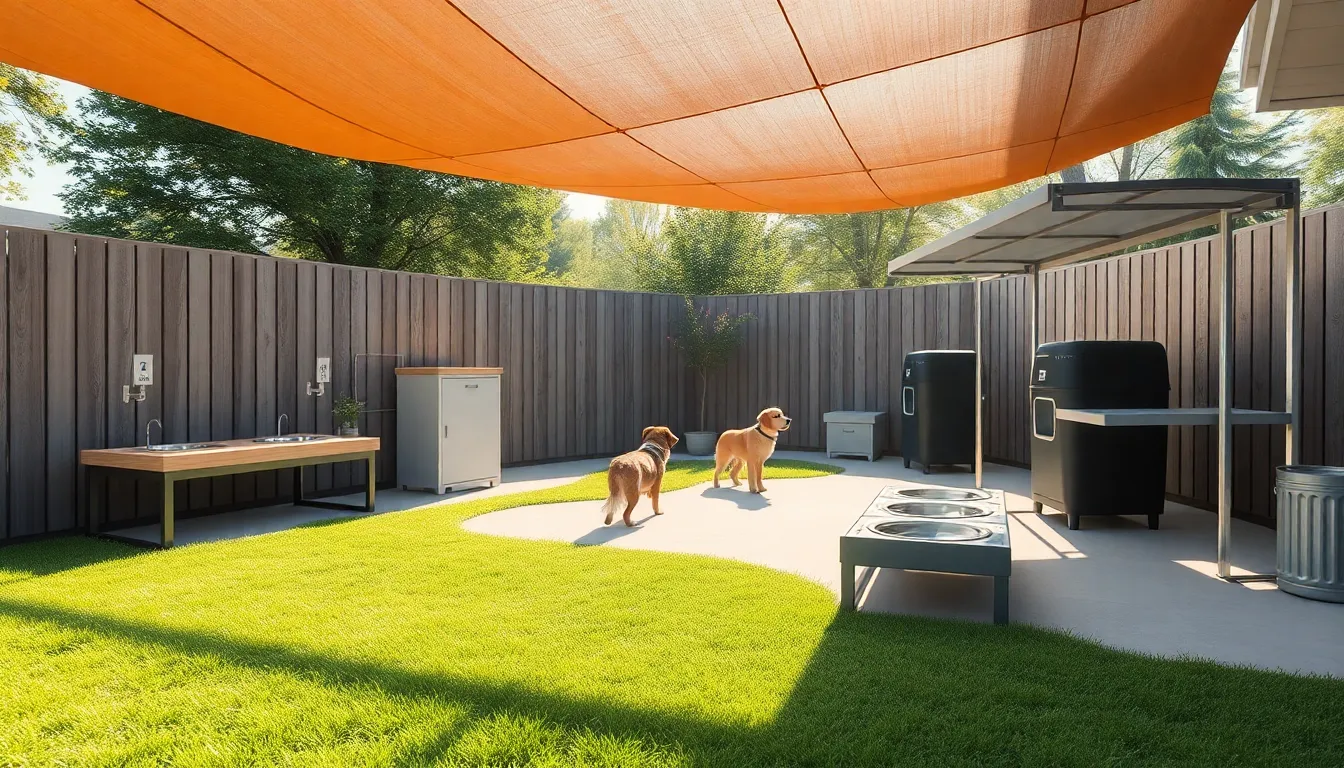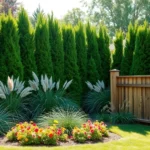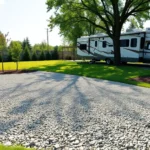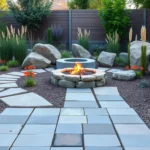Creating the perfect backyard dog run transforms your outdoor space into a canine paradise while giving you peace of mind. We’ve all watched our furry friends pace at the fence or dig escape routes under gates, desperately seeking more freedom and exercise. A well-designed dog run solves these problems by providing a dedicated space where your pup can sprint, play, and explore safely.
The benefits extend far beyond just containment. A thoughtfully planned dog run keeps your landscaping intact, reduces behavioral issues stemming from boredom, and ensures your pet gets adequate exercise even when you’re busy. Whether you’re working with a compact urban yard or sprawling suburban property, we’ll show you how to maximize every square foot.
From budget-friendly DIY answers to premium installations, we’ve compiled the most effective dog run ideas that actually work. These proven designs will have your four-legged family member living their best life while keeping your yard beautiful and functional.
Create a Simple Fenced Dog Run Area
Building a basic fenced enclosure provides the foundation for any successful backyard dog run. This straightforward approach offers immediate benefits while keeping costs manageable for most homeowners.
Choose the Right Location in Your Yard
Selecting the perfect spot requires balancing sun exposure with natural drainage. We recommend choosing an area that receives morning sun but offers afternoon shade, preventing overheating during hot summer days. Areas with natural slopes work well since they promote proper water drainage after rain or cleaning.
Avoiding low-lying spots prevents water accumulation and mud formation. Flat terrain near your home’s back door creates convenient access for daily use and monitoring. Distance from property lines should measure at least 3 feet to comply with most local regulations and maintain good neighbor relations.
Consider proximity to existing utilities when planning your layout. Locations near outdoor water spigots reduce installation costs for future upgrades like automatic waterers or cleaning stations. Areas visible from kitchen or living room windows allow easy supervision of your pet’s activities throughout the day.
Select Appropriate Fencing Materials
Chain link fencing remains the most popular choice for dog runs due to its durability and affordability. Standard 4-foot heights work well for most medium-sized dogs, while 6-foot options accommodate larger breeds or jumping dogs. Galvanized steel construction resists rust and weather damage for 15-20 years with minimal maintenance.
Wood privacy fencing creates attractive enclosures that blend with landscaping designs. Cedar and pressure-treated pine offer natural resistance to insects and rot, lasting 10-15 years with proper staining. Board-on-board styles eliminate gaps that small dogs might squeeze through while providing complete visual barriers.
Welded wire panels provide budget-friendly alternatives for temporary or seasonal installations. These lightweight options cost 30-50% less than permanent fencing but require replacement every 3-5 years. Metal posts with concrete footings ensure stability even with lighter panel materials.
Determine the Ideal Size for Your Dog
Calculating proper dimensions starts with your dog’s adult weight and activity level. Small dogs under 25 pounds need minimum areas of 6×8 feet, while medium dogs (25-60 pounds) require 8×10 foot spaces. Large breeds over 60 pounds benefit from 10×12 foot enclosures or larger to accommodate their stride length.
Active breeds need additional space beyond basic minimum requirements. High-energy dogs like Border Collies or German Shepherds perform better with 50% more area than sedentary breeds of similar size. Multiple dogs sharing the same run need individual space calculations plus 25% extra room to prevent territorial conflicts.
Length measurements matter more than width for running and exercise patterns. Rectangular shapes measuring 8×16 feet provide better movement opportunities than square 12×12 configurations of equal area. Dogs naturally prefer straight-line running paths rather than constant turning in compact spaces.
Build a DIY Chain Link Dog Run
Building your own chain link dog run offers excellent value and durability for creating a secure outdoor space. We’ll walk you through each step to construct a professional quality enclosure that keeps your pet safe while allowing plenty of exercise room.
Gather Essential Materials and Tools
Preparation saves time and ensures we have everything needed for a smooth installation process. Start by measuring your designated area to calculate the exact amount of chain link fencing required, keeping in mind that panels should be minimum 4 feet tall for smaller dogs and taller for larger breeds.
Essential materials include:
- Chain link fencing panels and matching gate
- Concrete mix for securing posts
- Industry fabric for weed prevention
- Ground cover materials such as pea gravel or sand
- Privacy slats for blocking distractions (optional)
- Treated 2×12 lumber for framing support
- Roofing materials if adding overhead protection
Required tools for the project:
- Post hole digger and spade for excavation
- Shovel and wheelbarrow for concrete mixing
- Adjustable wrench and lineman’s pliers for assembly
- Circular saw and hacksaw for cutting materials
- Level and tape measure for accurate installation
- Work gloves for safety during handling
Install Corner Posts and Gates
Corner post installation forms the foundation of your entire dog run structure. Mark your layout carefully using spray paint or stakes to ensure straight lines and proper dimensions before beginning any digging.
Dig post holes to a depth of at least 2 feet using your post hole digger, making each hole slightly wider than the post diameter. Set corner posts in concrete to provide maximum stability, allowing the concrete to cure for 24 hours before proceeding with fence installation.
Attach chain link panels to posts using tension bands and connecting ties, ensuring each panel is level and properly secured. Install your gate with a spring loaded snap clip latch rather than simple latches, as some intelligent dogs can learn to manipulate basic closure mechanisms.
Add Ground Cover Options
Ground preparation prevents muddy conditions and creates a clean surface for your dog’s daily activities. Lay industry fabric across the entire run area to block weeds while allowing proper drainage through the material.
Cover the fabric with your chosen ground material, with pea gravel offering excellent drainage and sand providing a softer surface for dogs who like to dig. Consider combining materials by using sand in high traffic areas and gravel along the perimeter for optimal results.
Adding overhead protection enhances your dog’s comfort during various weather conditions. Install treated lumber framing with plastic roofing or shingles to create a durable covered section that protects from both sun and rain while maintaining proper ventilation.
Design an L-Shaped Dog Run Layout
An L-shaped configuration transforms underutilized corner space into a functional and captivating dog run that maximizes your backyard’s potential. This strategic design approach creates distinct activity zones while maintaining easy access for maintenance and cleaning.
Maximize Corner Space Utilization
Corner areas naturally accommodate L-shaped dog runs, freeing up central yard space for other outdoor activities. Position fencing posts at corners and midpoints along each leg to ensure structural stability and clear boundary definition. Dogs can explore more area lengthwise while using corners as designated rest or play zones.
Strategic placement along existing property lines reduces fencing material costs and creates natural barriers. We recommend measuring your corner space first to determine the optimal dimensions for each leg of the L-shape. Install posts 1-2 feet deep at corner points to handle the additional stress from the angled configuration.
The extended perimeter of an L-shaped run provides more exploration opportunities compared to traditional rectangular designs. Corner positioning also takes advantage of existing shade patterns from fences, buildings, or industry features throughout different times of day.
Incorporate Multiple Activity Zones
Dividing your L-shaped run into functional zones keeps dogs mentally stimulated and physically active throughout the day. Create an active play zone in the longer section using durable surfaces like artificial grass or compacted gravel for running and fetch activities.
Establish a dedicated resting zone with shaded areas or raised platforms where dogs can relax and observe their surroundings. Position this quieter zone in the shorter leg of the L-shape to create natural separation from high-energy activities.
Activity Zone Options:
| Zone Type | Recommended Materials | Purpose |
|---|---|---|
| Active Play | Artificial grass, compacted gravel | Running, jumping, fetch |
| Resting Area | Mulch, raised platforms | Relaxation, observation |
| Potty Zone | Pea gravel, mulch | Easy cleanup, drainage |
| Training Space | Rubber mats, agility equipment | Mental stimulation, exercise |
Consider dedicating part of the run for elimination using materials like mulch or pea gravel that drain well and simplify cleaning routines. Add small obstacles, ramps, or tunnels in a training zone to provide mental enrichment and physical challenges.
Plan for Easy Maintenance Access
Design multiple access points with gates or removable panels to reach every section of your L-shaped run without disrupting your dog’s routine. Position the main gate at the corner junction for optimal accessibility to both legs of the configuration.
Install electrical outlets nearby to power automated cleaning systems, water features, or evening lighting for extended use during darker hours. Choose flooring materials like gravel or concrete that promote drainage and reduce mud buildup while planning for periodic replacement needs.
Create maintenance pathways wide enough for wheelbarrows or cleaning equipment to reach corners and tight spaces efficiently. We suggest installing removable fence panels in areas that require frequent access for deep cleaning or landscaping updates.
Ground preparation becomes crucial in L-shaped designs due to varied drainage patterns along different sections. Use industry fabric beneath ground cover materials to prevent weed growth and maintain clean boundaries between activity zones.
Construct a Covered Dog Run Structure
A covered dog run provides year-round outdoor access while protecting your pet from harsh weather conditions. This enhanced structure combines the benefits of a traditional dog run with overhead protection and improved climate control.
Install Roof or Canopy Protection
Corrugated metal roofing offers the most durable and cost-effective solution for covering your dog run. We recommend installing corrugated metal panels with proper slope to ensure rainwater runs off effectively without pooling on the surface. Metal roofing withstands wind, hail, and UV rays while requiring minimal maintenance over time.
Polycarbonate panels provide excellent light transmission while blocking harmful UV rays. These lightweight panels are easier to install than metal options and create a bright, airy environment for your dog. Polycarbonate resists impact damage and maintains clarity even after years of exposure to outdoor elements.
Heavy-duty outdoor fabric works well for temporary or seasonal coverage needs. We suggest choosing marine-grade canvas or waterproof polyethylene fabric that can withstand wind and rain. Fabric canopies offer flexibility in design and can be easily removed or adjusted based on weather conditions.
Proper installation techniques ensure your roof system remains secure during storms. Anchor all roofing materials to sturdy support posts set in concrete, and create adequate overhang to protect the sides of the run from driving rain.
Ensure Proper Ventilation
Strategic opening placement prevents heat buildup while maintaining protection from the elements. We recommend leaving gaps between the roof and upper fence sections to create natural airflow patterns. These openings should be positioned to take advantage of prevailing winds in your area.
Mesh or lattice panels in the side fencing allow continuous air circulation without compromising security. Install these ventilation panels on opposite sides of the run to create cross-ventilation that keeps temperatures comfortable during hot weather.
Elevated roof design creates natural convection currents that draw hot air upward and out of the structure. Position your roof at least 12 inches above the highest fence point to ensure adequate air movement beneath the canopy.
Ventilation considerations become critical in hot climates where temperatures can reach dangerous levels. Monitor the internal temperature of your covered run during peak summer hours and adjust ventilation openings as needed to maintain safe conditions.
Add Weather-Resistant Features
Durable material selection forms the foundation of a long-lasting covered dog run structure. We recommend using treated lumber, galvanized metal, or composite materials that resist rot, rust, and UV damage. These materials maintain structural integrity through multiple seasons of exposure.
Proper drainage systems prevent water accumulation that can create muddy conditions and health hazards. Install the floor with a slight slope toward drainage outlets, or add gravel substrate beneath artificial turf to help water movement away from the structure.
Integrated shelter areas provide additional protection during extreme weather events. Include a doghouse or covered alcove within the run where your pet can retreat during heavy rain, snow, or intense sun exposure.
Flooring options should balance comfort, drainage, and easy maintenance requirements. Consider artificial turf over a gravel base, concrete with textured surface treatment, or interlocking rubber mats that provide cushioning while allowing water to drain through gaps.
Maintenance accessibility ensures your covered dog run remains functional throughout its lifespan. Design entry points and cleaning access that allow you to reach all areas for regular maintenance, repairs, and deep cleaning as needed.
Establish a Natural Grass Dog Run
Natural grass dog runs offer the perfect blend of aesthetics and functionality for your backyard space. This option provides a comfortable, breathable surface that’s safer for your dog while maintaining the beauty of your industry.
Prepare the Ground Surface
Ground preparation forms the foundation of a successful natural grass dog run. Start by removing all existing turf and debris to create a clean, level base that prevents puddles and uneven surfaces.
Install a base layer of sand or gravel beneath the grass area for improved drainage and stability. This foundational layer helps manage water flow and prevents the muddy conditions that commonly plague dog runs.
Consider hybrid turf options like Natura if you want to protect underlying soil while supporting natural grass growth. These breathable surfaces promote healthy grass development and provide enhanced safety for your pets.
Level the entire area carefully to ensure proper water drainage patterns throughout the space. Uneven surfaces create standing water problems that lead to unhealthy conditions and grass damage over time.
Choose Dog-Safe Grass Varieties
Hardy grass varieties withstand the heavy foot traffic and play activities that dogs bring to outdoor spaces. Kentucky Bluegrass, Perennial Ryegrass, and Tall Fescue offer excellent durability for high-traffic dog areas.
Avoid grass types that require frequent fertilization or pesticide treatments to protect your dog from harmful chemical exposure. These maintenance-heavy varieties pose unnecessary health risks and increase ongoing care costs.
Natural grass maintenance requires dedication and preparation for brown spots, ruts, and challenging mowing conditions within the dog run area. Regular upkeep includes overseeding damaged areas and managing wear patterns from your pet’s activities.
Select wear-resistant varieties that recover quickly from damage and maintain their appearance even though frequent use. These grass types bounce back faster from the digging, running, and playing that dogs naturally engage in.
Carry out Drainage Answers
Proper drainage prevents the muddy, smelly, and unhealthy environments that plague poorly designed dog runs. Effective water management keeps your grass healthy and your pet comfortable throughout the year.
Slope the ground slightly away from structures to encourage natural runoff and prevent water accumulation near your home. This simple grading technique directs water flow toward appropriate drainage areas.
Install underground drainage pipes or gravel bed layers beneath the grass surface to enhance water movement through the soil. These subsurface systems handle heavy rainfall and frequent watering without creating surface problems.
Hybrid turf systems like Natura allow urine to drain naturally into the soil, reducing odor buildup and eliminating the need for harsh cleaning chemicals. This natural filtration system maintains a cleaner, healthier environment for both pets and family members.
Create multiple drainage points throughout larger dog run areas to prevent water from pooling in low spots. Strategic placement of these drainage elements ensures consistent water management across the entire space.
Set Up a Gravel-Based Dog Run
Creating a gravel dog run offers excellent drainage and low maintenance compared to natural grass options. This approach provides a durable surface that withstands heavy use while keeping your pet comfortable.
Select the Right Gravel Type
Pea gravel stands out as the top choice for dog runs because its smooth, rounded stones feel comfortable under your pet’s paws. This material provides excellent drainage while creating a safe walking surface that won’t injure sensitive paw pads.
Sharp or angular gravel types should be avoided since they can cause discomfort or cuts to your dog’s feet. Crushed stone serves as an alternative option but requires careful selection to ensure smooth edges.
Eco-friendly pavers designed specifically for pet areas offer another premium choice, though they typically cost more than traditional gravel options. These specialized materials combine durability with pet safety features.
Create Proper Base Preparation
Clear the designated area by removing all grass, weeds, and topsoil to establish a level foundation for your gravel dog run. This step ensures proper drainage and prevents future weed growth through the gravel layer.
Install a durable weed barrier fabric over the entire cleared area to block unwanted vegetation from sprouting through your gravel surface. This fabric extends the lifespan of your dog run while reducing maintenance requirements.
Compact the base using a plate compactor or hand tamper after spreading the gravel evenly across the prepared area. This compression creates a firm, stable surface that won’t shift under your dog’s weight during active play sessions.
Install Edging and Borders
Industry edging materials like wood, plastic, or metal help contain the gravel within your designated dog run boundaries. These borders prevent gravel from migrating into other yard areas while maintaining clean, defined edges.
Strategic placement of these borders creates a professional appearance that complements your overall industry design. The edging also makes maintenance easier by clearly defining the area that needs attention.
Proper installation of borders ensures they can withstand your dog’s activity level and prevent gravel displacement during enthusiastic play sessions. Choose materials that match your yard’s aesthetic while providing the durability needed for long term use.
Install an Above-Ground Dog Run System
Above-ground dog run systems offer excellent flexibility for creating a customized outdoor space that blends seamlessly with your existing industry. We’ll explore the key considerations for selecting and installing these versatile systems.
Consider Portable Run Options
Portable dog runs provide maximum flexibility through their modular panel design that assembles and disassembles quickly. Chain link and mesh fencing sections represent the most popular portable options, offering lightweight construction without sacrificing security for your pet.
Flexibility becomes the primary advantage when you need to relocate the run across different yard areas or transport it during travel. Most portable models feature interlocking panels that snap together without requiring tools or permanent installation methods.
Storage convenience makes portable runs ideal for seasonal use or households with changing outdoor space needs. We recommend selecting models with carrying cases or compact folding capabilities to simplify transport and storage between uses.
Weight considerations vary significantly between different portable run materials, with aluminum frames offering the lightest option while steel provides superior durability. Most quality portable systems balance these factors by using galvanized steel frames with weather resistant coatings.
Plan for Easy Assembly and Disassembly
Modular panel systems with interlocking features eliminate the need for complex tools during installation and removal processes. Snap-in connectors and pre-drilled holes streamline the construction process while maintaining structural integrity throughout multiple assembly cycles.
Tool requirements should remain minimal for optimal convenience, with most quality systems requiring only basic hand tools like screwdrivers or Allen wrenches. We suggest avoiding systems that demand specialized equipment or professional installation for maximum user accessibility.
Assembly time typically ranges from 30 minutes to 2 hours depending on the run size and complexity of the design. Corner brackets and reinforcement hardware often determine the speed of installation, with quick-release mechanisms offering the fastest setup times.
Instructions clarity directly impacts the ease of assembly, so we recommend reviewing manufacturer documentation before purchase. Video tutorials and step-by-step guides significantly reduce installation challenges and prevent common assembly mistakes.
Ensure Stability and Safety
Ground anchoring systems provide essential stability for above-ground runs, preventing movement during active play sessions or adverse weather conditions. Spiral stakes, concrete anchors, and weighted bases offer different securing methods depending on your ground surface and permanence requirements.
Weather resistance requires careful material selection to withstand UV exposure, rain, and temperature fluctuations without deteriorating. Galvanized steel frames with powder coating finishes demonstrate superior longevity compared to basic painted or untreated materials.
Safety features include rounded corners, secure latching mechanisms, and gap-free panel connections that prevent escape attempts or injury risks. We recommend inspecting all connection points regularly to ensure hardware remains tight and functional over time.
Shade integration within the run design protects your pet from sun exposure and provides comfort during extended outdoor time. Retaining walls, stepping stones, and artificial grass additions create stimulating environments while maintaining safety standards for active dogs.
Incorporate Agility Features Into Your Dog Run
Adding agility features transforms your basic dog run into an captivating playground that challenges your pet physically and mentally. We’ll explore how incorporating these elements can boost your dog’s coordination, balance, and fitness while providing the outdoor enrichment they crave.
Add Jumping and Climbing Elements
Jumping obstacles create exciting challenges that engage different muscle groups and keep your dog active throughout their exercise time. We recommend starting with low hurdles made from PVC pipes or wooden planks that can be adjusted based on your dog’s size and skill level. Tire jumps offer another ever-changing option that encourages dogs to judge distances and develop coordination skills.
Climbing structures add vertical challenges that many dogs find irresistible and mentally stimulating. Wooden ramps with non-slip surfaces work well for dogs of all ages, while inclined platforms create opportunities for balance training. We suggest building stairs or stepped platforms using weather-resistant materials that can withstand outdoor conditions and heavy use.
Adjustable equipment allows you to modify difficulty levels as your dog’s abilities improve over time. Consider installing jumping bars with multiple height settings or creating modular climbing elements that can be reconfigured. This flexibility ensures your agility features remain challenging and captivating as your pet develops new skills.
Include Interactive Play Equipment
Treat-dispensing puzzles mounted securely within the run provide mental stimulation and reward-based play during exercise sessions. We recommend choosing weather-resistant puzzle feeders that can be refilled easily and cleaned regularly. These interactive elements help reduce boredom and destructive behaviors while encouraging problem-solving skills.
Textured surfaces create different tactile experiences that engage your dog’s senses and provide natural enrichment opportunities. Consider adding sections of different materials like rubber mats, artificial turf, or safe wooden planks to create variety. These surfaces also help with paw conditioning and can serve as designated rest areas within the run.
Fixed interactive features eliminate the need for constant toy replacement while providing consistent entertainment value. We suggest installing durable chew toys on springs, balls attached to ropes, or rotating puzzle elements that can withstand weather exposure. Pet-safe plants around the perimeter can also create natural interactive elements that stimulate your dog’s curiosity.
Design Training Obstacle Courses
Weave poles develop your dog’s agility and obedience while providing structured exercise that strengthens your bond together. We recommend spacing poles 18-24 inches apart for most dogs, using flexible materials that won’t cause injury if contacted. This equipment helps improve your pet’s focus and responsiveness to commands during playtime.
Balance beams challenge your dog’s coordination while building confidence in handling different surfaces and heights. Start with low, wide beams made from treated lumber with non-slip surfaces for safety. These elements can be positioned at various angles to create different difficulty levels as your dog’s skills progress.
Tunnel systems provide exciting hiding spots and crawling challenges that many dogs find irresistible and confidence-building. We suggest using flexible drainage tubes or purpose-built agility tunnels that can be curved or kept straight. These features encourage dogs to follow commands and navigate obstacles while providing natural enrichment through exploration.
Command stations throughout the course create opportunities for training reinforcement and skill development during exercise time. Position small platforms or designated spots where your dog can practice sits, stays, and other commands between obstacles. This structured approach helps improve training progress while making exercise sessions more interactive and rewarding.
Plan for Shade and Shelter Elements
Creating comfortable spaces within your dog run requires thoughtful planning for shade and shelter elements. These protective features ensure your pet enjoys year-round outdoor access while staying safe from harsh weather conditions.
Install Permanent Shade Structures
Build covered roofs or integrated doghouses for the most reliable protection from sun and rain. These permanent structures provide consistent shelter that dogs can rely on throughout all seasons. Incorporating part of your house or an existing shed as one side of the dog run naturally creates shade while reducing construction costs and materials needed.
Construct roofed areas using durable materials like corrugated metal or polycarbonate panels for long-lasting coverage. Simple dog run designs with overhead protection can be built quickly and offer immediate comfort for dogs resting outdoors. Permanent structures also add value to your property while creating a professional appearance for your backyard setup.
Design attached structures that connect to your home’s existing architecture for seamless integration. This approach maximizes the use of existing walls and provides natural windbreaks during storms or high winds. Attached permanent shade eliminates the need for additional support posts in some areas.
Add Portable Shelter Options
Use pop-up tents and movable canopy shades for flexible protection that adapts to changing weather conditions. These portable options complement permanent structures by offering additional shaded areas during particularly hot or rainy days. Portable shelters can be repositioned throughout the day to follow shade patterns or stored away when not needed.
Select weather-resistant portable structures made from UV-protected fabrics and sturdy frames that withstand outdoor conditions. Portable canopies work especially well for seasonal use or when you need temporary coverage in different areas of the run. These options provide cost-effective answers for expanding shade coverage without permanent installation.
Position movable shelters strategically to create multiple retreat areas within larger dog runs. Portable options allow you to experiment with different shade configurations before committing to permanent installations. This flexibility proves valuable when accommodating dogs with varying preferences for sun and shade exposure.
Consider Natural Shade Answers
Plant pet-friendly trees and tall shrubs around the dog run perimeter to create cost-effective natural shade coverage. Natural shade from vegetation offers filtered sunlight that creates cooler areas while adding sensory variety and mental stimulation to your dog’s environment. Trees and shrubs also enhance the overall aesthetic appeal of your backyard space.
Choose fast-growing, dog-safe plants that provide quick shade establishment without toxic risks to your pets. Natural shade answers reduce the need for artificial structures while creating a more varied and captivating outdoor setting for dogs. Living shade elements also improve air quality and provide natural windbreaks.
Design landscaping elements that offer both shade and environmental enrichment through different textures and scents. Natural answers work particularly well when combined with permanent and portable options to create comprehensive coverage throughout the dog run area. Strategic plant placement can also help direct airflow and create natural cooling effects during hot weather.
Include Water and Feeding Stations
We’ve covered the structural elements and enrichment features of your backyard dog run, but now it’s time to focus on the essential daily needs that keep your dog healthy and comfortable. Proper hydration and nutrition stations are fundamental components that transform a simple enclosed area into a fully functional living space for your pet.
Set Up Automatic Water Systems
Install automatic water dispensers to provide continuous fresh water access throughout the day. Pet water fountains and gravity fed dispensers eliminate the risk of dehydration during hot weather while reducing your daily maintenance tasks.
Position water systems in shaded areas to keep the water cool and prevent algae growth. Mounting automatic waterers on fence posts or installing ground level fountains ensures your dog can access fresh water without contamination from dirt or debris.
Connect plumbed water systems for the ultimate convenience if your dog run is located near existing water lines. These permanent installations provide unlimited fresh water and can include freeze proof features for year round operation in colder climates.
Add backup water sources such as elevated water bowls in case automatic systems malfunction. Multiple water access points throughout larger dog runs ensure your pet stays hydrated regardless of which area they’re playing in.
Design Weather-Proof Feeding Areas
Create covered feeding stations under roofed sections of your dog run to protect food and water from rain and snow. Installing partial covers or extending existing shelter structures prevents weather from spoiling meals and diluting water supplies.
Use elevated feeding platforms that raise bowls 6 to 12 inches off the ground to improve drainage and reduce contamination. Stainless steel or ceramic bowls resist weather damage better than plastic options and maintain hygiene standards in outdoor environments.
Install windscreen barriers around feeding areas to prevent food from scattering during windy conditions. Strategic placement of solid fence panels or custom built feeding alcoves creates calm zones where your dog can eat without distractions.
Select weather resistant feeding equipment including rust proof bowl holders and UV protected storage containers for dry food. Waterproof feeding mats and non slip surfaces ensure bowls stay in place during storms while protecting the ground from spills.
Plan for Easy Cleaning and Maintenance
Choose smooth ground surfaces like artificial turf, pea gravel, or concrete around feeding stations for quick waste removal and sanitization. These materials don’t retain odors and allow you to hose down areas efficiently after meals.
Install removable feeding trays or waterproof mats under bowl stations to simplify daily cleaning routines. Portable platforms can be taken to washing areas while permanent installations should include drainage slopes to direct water away from the run.
Design multiple access points to feeding areas so you can reach all stations without walking through the entire run. Strategic gate placement and wide pathways make it easy to deliver fresh food and water while removing soiled bedding or toys.
Create storage answers within or adjacent to the dog run for cleaning supplies, extra bowls, and food storage containers. Weather proof storage boxes or built in cabinets keep maintenance tools organized and readily available for daily upkeep tasks.
Conclusion
Creating the perfect backyard dog run transforms your outdoor space into a haven for your furry family members. We’ve explored everything from basic fenced areas to elaborate covered structures with agility features that keep dogs engaged and active.
The key to success lies in thoughtful planning that considers your dog’s exact needs and your yard’s unique characteristics. Whether you choose a simple gravel-based design or an elaborate L-shaped layout with multiple activity zones you’re investing in your pet’s health and happiness.
Remember that the best dog run combines functionality with comfort. By incorporating proper drainage shade structures and daily amenities like automatic water systems you’ll create a space your dog will love spending time in year-round.
Frequently Asked Questions
What is a backyard dog run and why do I need one?
A backyard dog run is a designated, fenced area where dogs can safely play, exercise, and relieve themselves. It provides a secure space that protects your landscaping, reduces behavioral issues, and gives your pet freedom to roam without supervision. Dog runs benefit both small and large yards by creating structure and maintaining your outdoor space.
How do I choose the right location for my dog run?
Select a location that balances sun exposure and shade throughout the day. Avoid low-lying areas prone to flooding and ensure good drainage. Choose a spot with convenient access from your home for easy monitoring and maintenance. Consider your dog’s viewing preferences and proximity to property lines for cost-effective fencing.
What size should my dog run be?
The ideal size depends on your dog’s weight and activity level. Active breeds require more space than sedentary dogs. Rectangular shapes are preferable for exercise and running. As a general rule, larger dogs need more room to move comfortably, while smaller dogs can thrive in more compact spaces.
What are the best materials for dog run fencing?
Chain link fencing offers durability and visibility, making it popular for dog runs. Wood privacy fencing provides security and aesthetics but requires more maintenance. Welded wire panels are cost-effective and easy to install. Choose materials based on your budget, dog’s size, and desired level of privacy.
How do I prepare the ground for a dog run?
Start by clearing the area and removing existing vegetation. Install a weed barrier, then add a base layer of sand or gravel for drainage. For grass runs, select hardy, dog-safe varieties. For gravel runs, use pea gravel and compact it properly. Ensure proper sloping for water drainage.
Should I add a roof or cover to my dog run?
A covered dog run provides year-round protection from weather elements like rain, snow, and excessive sun. Use durable materials like corrugated metal or polycarbonate panels. Ensure proper ventilation and consider your climate needs. Covers are especially beneficial in areas with extreme weather conditions.
What ground cover options work best for dog runs?
Pea gravel offers excellent drainage and low maintenance. Natural grass provides comfort but requires more upkeep. Sand is affordable but can be messy. Rubber mulch is soft and safe but more expensive. Consider your climate, budget, and maintenance preferences when choosing ground cover.
How can I make my dog run more engaging?
Add agility features like hurdles, ramps, and tunnels for physical exercise. Include interactive elements such as treat-dispensing puzzles and textured surfaces for mental stimulation. Create distinct zones for different activities like playing, resting, and training. Rotate toys and equipment to maintain interest.
What shelter and shade options should I include?
Install permanent structures like covered roofs or integrated doghouses using weather-resistant materials. Consider portable options like pop-up tents for flexibility. Plant pet-friendly trees and shrubs around the perimeter for natural shade. Ensure shelter protects from both sun and precipitation.
How do I maintain proper hydration and feeding in the dog run?
Install automatic water systems positioned in shaded areas to keep water cool. Create weather-proof feeding stations with elevated platforms and wind barriers. Use smooth ground surfaces for easy cleaning. Ensure easy access points for daily maintenance and cleaning of food and water areas.




